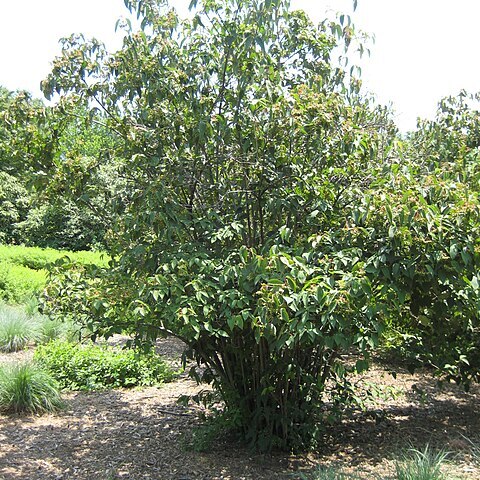Shrubs, deciduous, to 4 m tall. Bark light brown. Winter buds and leaves black, black-brown, or gray-black when dry. Branchlets of current year grayish yellow, glabrous; branchlets of previous year gray, gray-brown, or purple-brown, terete, glabrous, with dispersed, small, rounded lenticels. Winter buds oblong, usually less than 5 mm, to 1 cm at most, with 2 pairs of separate scales, outer ones 1/3-1/2 as long as inner ones; scales glabrous. Leaves always opposite, not clustered at apices of branchlets; stipules absent; petiole green, slender, 1-1.5(-2.5) cm, sparsely adpressed long hairy or subglabrous; leaf blade green when young, ovate-oblong to ovate-lanceolate, rarely ovate to elliptic-ovate, 7-12(-15) × 3-5.5 cm, papery, abaxially yellowish adpressed long hairy only on midvein and lateral veins, adaxially long hairy, glabrescent, midvein raised abaxially, lateral veins 6-8-jugate, pinnate, straight, rarely branched, ending in teeth, conspicuously raised abaxially, slightly impressed adaxially, veinlets transverse, slightly raised abaxially, impressed adaxially, not lobed, base rounded, with 1 or 2 circular glands on both sides of midvein near base, margin remotely serrate except at base, apex acuminate. Flowers appearing after leaves; inflorescence a compound umbel-like cyme, often nodding, terminal, 2.5-4(-5) cm in diam.; rays whorled; first node of inflorescence usually with 5 rays, dense, glabrous or sparsely adpressed long hairy, without large sterile radiant flowers; peduncles 1-2.5(-3.5) cm; bracts and bracteoles deciduous, leaflike, green, lanceolate, glabrous. Flowers on rays of 3rd order, not fragrant, shortly pedicellate or sessile. Calyx green; tube tubular, ca. 1.5 mm, glabrous; lobes ovate, ca. 1 mm, glabrous, apex obtuse. Corolla white, rotate, 4-6 mm in diam., glabrous; tube 1-2 mm; lobes spreading, ovate, ca. 2.5 mm, exceeding tube, apex rounded, margin entire. Stamens subequaling corolla, inserted at base of corolla; filaments ca. 3 mm; anthers yellow-whitish, globose, very small, less than 1 mm. Styles not exceeding calyx lobes; stigmas capitate. Fruit maturing red, ovoid, 9-11 mm, base rounded, apex rounded, glabrous; pyrenes very compressed, ovoid, 8-10 × 5-7 mm, sometimes much smaller, occasionally ovoid-oblong, only 4-5 mm in diam., slightly impressed on ventral side, apex rounded. Fl. Apr-May, fr. Sep-Oct. 2n = 18*.
More
A shrub. It grows 1.5-3.5 m high and spreads 2 m wide. It loses its leaves during the year. The leaves are large and oblong and dark green. They are paler and woolly underneath. The leaves change colour in autumn. The flowers are small. The fruit are orange and red. They are oval.

